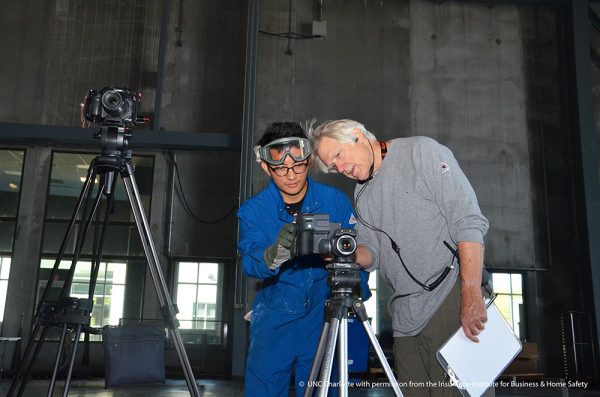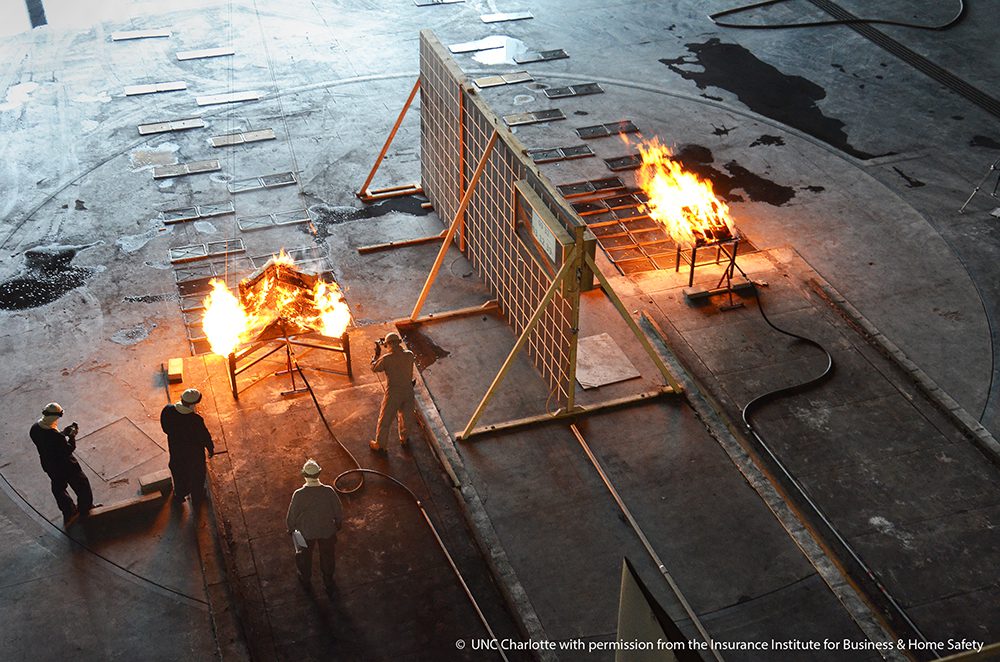Research Teams Collaborating to Better Understand Wildfire Spread

With a wall of fans six-stories high creating winds in a huge, one-of-a-kind laboratory, researchers from UNC Charlotte’s Fire Safety Engineering Technology program and the Insurance Institute for Business and Home Safety (IBHS) are burning building materials and wildland vegetation to study wind-driven wildfire embers. The large-scale tests are part of three-year study to understand, and in the long run mitigate, the risks involved when embers from wildfires spread.
Sponsored by the Joint Fire Science Program (JFSP), the $420,000 “Fire Ember Production from Wildland and Structural Fuels” project brings together researchers from seven institutions. Dr. Aixi Zhou, an associate professor in the Fire Safety Engineering Technology Department, is the principle investigator on the project.
“The project addresses the emerging problems we face as a nation with wildfire,” Dr. Zhou said. “Human safety and property damage risks are increasing as development continues to get closer and closer to wildland areas. The number of wildfires is also increasing, as warmer temperatures and drought conditions are leading to more fires such as those in the North Carolina and Tennessee mountains in fall 2016.”
The objective of the JFSP project is to gain a better understanding of the embers produced during a wildfire and to characterize them based on size and mass. The research includes small-scale laboratory ignition tests and large-scale tests where vegetative and structural materials are burned in a wind tunnel.
“We are fortunate to have an excellent team to undertake these tasks,” Dr. Zhou said, “with unique expertise and research capabilities from each project partner.”
In addition to UNC Charlotte, the partnering researchers include IBHS, the Pacific Southwest Research Station of the US Forest Service, the University of Texas, the University of Maryland, the Fire Protection Research Foundation at the National Fire Protection Association, and the JFSP Southern Fire Exchange at the University of Florida.
The project involves testing building materials and vegetation that are native to the participating members’ regions. These include common construction materials used for siding, roofing and fencing. Vegetation include native trees, shrubs and grasses.
In the first part of 2016, UNC Charlotte researchers did small-scale laboratory tests using a cone calorimeter to determine combustion characteristics, and thermogravimetric analysis (TGA) equipment to study the pyrolysis properties of samples. In the later part of 2016, the team began large-scale test at IBHS’s Research Center in Richburg, South Carolina. “They have the only facility in the U.S. that can do this scale of tests,” Dr. Zhou said.
The IBHS Research Center includes a specially designed wind tunnel that is six-stories tall, 145 feet wide and 145 feet long. The test chamber contains a wall of 105 fans, each nearly six feet in diameter and driven by a 350 HP engine.
 Dr. Steve Quarles, chief scientist for Wildfire and Durability with IBHS, is a co-investigator on the JFSP project. He has been working with UNC Charlotte fire safety researchers on several projects during the past three years.
Dr. Steve Quarles, chief scientist for Wildfire and Durability with IBHS, is a co-investigator on the JFSP project. He has been working with UNC Charlotte fire safety researchers on several projects during the past three years.
“We each have expertise and research equipment in certain areas,” Dr. Quarles said. “By working together, we all benefit.”
The benefits extend to the undergraduate and graduate students working on the project.
“Working at our facility lets the students apply what they are learning in school into a large laboratory situation,” Dr. Quarles said. “These tests involve a lot of steps and details, and the students have gotten very comfortable with their tasks. Overall it’s been a good experience for both of us.”
As a non-profit, member-based organization, IBHS performs research on behalf of its insurance industry members. “This project will ultimately provide members with information that helps them better manage their risks,” Dr. Quarles said. The end goal is to learn how to prevent or reduce property damage from wildfires. IBHS issues public safety tips and guidelines on a number of natural-disaster risks, including wildfires, to help people understand the steps they can take to protect their homes and businesses.
To perform the research that generates this information, UNC Charlotte has two Ph.D. and one master’s student involved in the project as part of their theses work. Three undergraduates are working on the test as research assistants.
“This type of experience gets the students out in the field to learn,” Dr. Zhou said. “Experiential learning is a key to all of our academic programs.”
The experiential learning has included everything from trips to the Charleston area to collect Palmetto plants for testing, to doing the small-scale laboratory materials test. It has also included trips to the IBHS Research Center to do large-scale burns.
 To determine ember spreading characteristics, separate tests are done for each of the materials and plants. Setup in the IBHS test chamber starts with mounting materials in front of a grid background screen. A number of cameras are positioned and coordinated to record images. The samples to be burned are instrumented and all the data is fed to a control room. Downwind of the tests, a number of water trays are set up to collect embers.
To determine ember spreading characteristics, separate tests are done for each of the materials and plants. Setup in the IBHS test chamber starts with mounting materials in front of a grid background screen. A number of cameras are positioned and coordinated to record images. The samples to be burned are instrumented and all the data is fed to a control room. Downwind of the tests, a number of water trays are set up to collect embers.
Once setup is complete, the burning starts and the fans are turned on to simulate the winds that occur during a wildfire. The length of the test is dependent on the type of material being burned. Once the burn is complete, work begins to document the results. Then there is cleanup and setup for next test. The entire process is labor-intensive and time-consuming.
“The tests are going well, and we are right on track with the overall project,” Dr. Zhou said. “We have good team that works well together. The next step will be to analyze the data we have collected so far. The eventual end product will be an understanding of the different materials, so we can create ignition resistance strategies for embers.”
JFSP is a partnership of six federal wildland management and research agencies that addresses problems associated with managing wildland fuels, fires and fire-impacted ecosystems. The partnering agencies include the U.S. Department of Agriculture, Forest Service and five bureaus in the U.S. Department of the Interior: Bureau of Indian Affairs, Bureau of Land Management, National Park Service, Fish and Wildlife Service, and the Geological Survey.